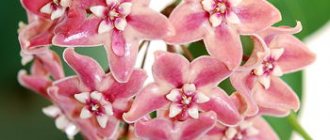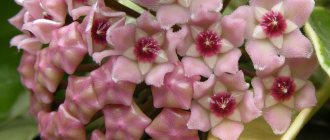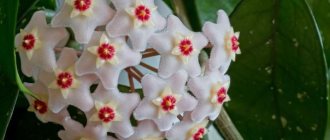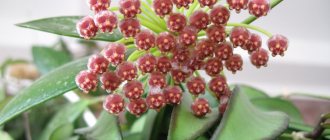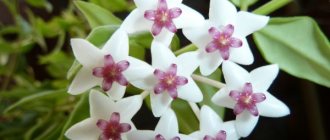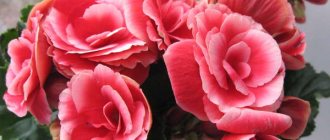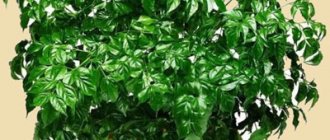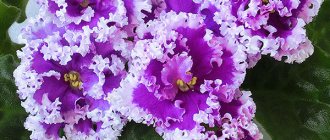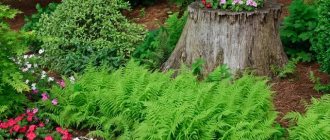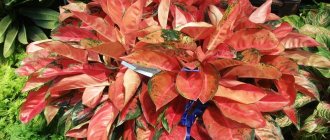Plants » Flowers
0
332
Article rating
Larisa Kosterina
One way to obtain plant varieties is through cross-pollination. This is usually a purposeful action. But in 1994, only chance gave a new variety - the charming Hoya Matilda.
Hoya Matilda photo
Characteristics of the variety
Breeding history
In the greenhouse of the Belgian botanist Begine, Hoya Carnosa and Hoya Serpens bloomed nearby.
Outside their natural habitat, pollination is difficult. The Belgian developed an unusual pod on one of the flowers, which gave seeds to 2 new plants. One of the varieties was named after the Queen of Belgium, Mathilde.
The full name of the variety is hoya cv. Mathilde splash. Here cv. = cultivar indicates its hybrid origin. Silvery specks on the leaves, similar to drops of water, led to the addition of splash.
External parameters
The homeland of the Hoyaceae family is Southeast Asia and Australia. During the selection process, this ornamental plant became more compact.
In apartments where there is a shortage of space, Hoya struggles for life on the verticals. It can be cultivated on supports as a climbing plant or as a hanging plant. Hoya Mathilde splash has:
- stems up to 1.5 mm thick;
- oval leaves 3 cm long and 2 cm wide;
- flower umbrellas consisting of 15-20 flowers. The corolla of the flower is white or pale pink, 2 cm in diameter. The crown is white with a red center.
Under favorable conditions, flowering lasts all year round.
The long history of the spectacular flower called hoya
Hoya is native to southeast Asia, northeast Australia and the islands between these continents. It was born in the humid and hot tropics and grows mainly in sunny woodlands or on the edge of the forest. The stems of wild-growing hoya, covered with thick leaves, grow up to 10 meters; for development they need support: a tall tree or a rocky wall. Some species lead an epiphytic or semi-epiphytic lifestyle. That is, they can live without soil or, having settled at a height, they descend roots and grow into the soil. Wild hoyas are good honey plants. Their flowers are attractive and emit a strong aroma.
In pursuit of the sun, Hoya climbs tall trees and rocks
It is believed that Malaysian sailors helped spread the flowering vine. They transported not only cargo, but also useful and beautiful plants, including hoya.
Hoya was first described in the 17th century by the Dutch missionary Guernius. He talked about a plant with succulent and smelly flowers.
It is impossible to pass by the hoya inflorescences, they are mesmerizing
However, then the hoya did not fall into the hands of scientists. This happened more than a hundred years later, partly thanks to the famous traveler James Cook. His ship landed on the northeastern coast of Australia. There, scientists Solender and Banks discovered an original plant with fleshy leaves and fragrant clusters of flowers that seemed to be made of wax. They brought the strange plant to Europe, marking the beginning of “hoyemania,” which continues to this day.
For a long time, the new tropical plant did without a generic name; it appeared only in the 18th century. Varieties of the flower were given the names of famous scientists, but the common name “hoya” immortalized the name of a simple English gardener, Thomas Hoy. He worked in the Duke of Northumberland's greenhouse and managed to tame many exotic plants. They say that the brilliant gardener intuitively guessed the whims of his green pupils.
Over 200 species of hoya are now grown in indoor floriculture. These representatives of the tropics have adapted well to northern latitudes. But the study and selection of Hoya is not completed. And the best breeder is nature itself. Scientists are discovering new varieties of hoya in Borneo, the Philippines and in the 21st century.
Hoya is often called wax ivy. Its leaves and flowers seem to be covered with a waxy coating. And the long stems resemble ivy lashes. However, hoya has nothing to do with real ivy. Ivy, unlike its beautiful impostor, never blooms. The only thing that brings them together is their shape. These plants are vines and require support or a hanging planter to thrive.
Most hoi have fleshy, often variegated leaves.
Different types of hoya differ quite significantly from each other. But they all have common characteristics. These are long, well-leafed shoots with aerial roots. The leaves can be quite large (on average 10 cm), shiny and fleshy, or small (2.5 cm), matte and thin. The color is plain dark green or variegated, with contrasting spots, dots or a border.
Fuzzy hoya flowers are fantastically beautiful
The flowers are succulent, collected in inflorescences-umbrellas or balls, almost always resembling an asterisk. But its tips can be flat, strongly bent or concave. And the surface of the flower is glossy and smooth or fluffy. The shades of the inflorescences also vary. From classic white and pink to chocolate and burgundy. Almost all hoyas smell. Opinions about their aroma vary greatly. Some people find it pleasant, but others find it repulsive. Well-groomed hoya blooms for a long time, and sometimes several times a year.
Hoya bella has small, thin leaves and is grown in hanging flower pots.
Hoya, despite its exotic appearance, is not the most difficult plant to care for. At home, this flowering vine has been successfully grown for centuries. During this time, flower growers have accumulated vast experience. It is only important to take into account the characteristics of individual types of hoya. What is good for a plant with succulent leaves is not always suitable for a small-leaved variety. This applies to lighting, humidity and winter conditions. There are several subtleties associated with hoya flowering. But they are easy to do. So hoya can be recommended even to inexperienced gardeners.
Matilda, optimist, megalaster, Kerry, Bella and descriptions of other species
Those who have a hoya fall in love with this plant seriously and for a long time. They are adding new items to their collections. From the variety of hoyas, each gardener can choose the one that fascinates him. And almost everyone has their favorites. After all, hoya is a many-sided plant. Let's get acquainted with the most prominent representatives of this wonderful family.
Hoya Kerry is the most commercial variety. It is sold not only in flower shops, but also in souvenir shops. Rooted heart-shaped leaves in decorated pots appear on sale on the eve of Valentine's Day. They have become a symbol of living, unfading love.
Heart leaves - an original gift for Valentine's Day
- Hoya Kerry has been known in floriculture since the beginning of the 20th century. The plant received the name of its discoverer. Professor Kerry discovered a liana in the Thai tropics. Hoya Kerry has large (up to 15 cm) dense glossy leaves in the shape of a heart on 2-meter stems. Because of this, the plant was nicknamed Valentine or Hoya in Love. And the flowers of this variety are small, in inflorescences of 15–25 pieces, painted in the traditional pink and white color and can be yellow-lemon. The shade depends on the lighting and age of the plant.
- Kerry variegata is a variety with variegated foliage. Green heart leaves may have a white, yellowish or creamy center. Its boundaries are blurred, as if the paint was carelessly erased. Or the middle is green and the edges are colored. There are varieties with leaves on which strokes and spots are randomly scattered.
- Hoya carnosa is often called wax ivy. It has long grayish shoots and fleshy shiny leaves. They are medium in size (up to 10 cm), in the shape of a pointed oval, emerald in color, sometimes with barely noticeable lighter spots. The flowers, which have a pleasant scent, are pale pink glossy in the shape of a star, and in the middle there is a red corolla star. This variety has earned recognition from flower growers for its unpretentiousness in growing at home. In nature, Hoya carnosa is common in Japan, China, India, the Pacific Islands and Australia.
- Hoya beautiful (Bella) is native to Indonesia and India. This is a compact plant that is often grown as a hanging plant. It has matte small (2.5 cm) and thinner leaves compared to other varieties. The flowers are sometimes odorless, they have a classic structure for hoya: on a larger white star there is a small bright transparent red one.
- Hoya bogor is a liana with narrow, hard, slightly variegated leaves. Its inflorescences consist of flowers with a larger lower “star” with slightly bent blades wavy along the edge.
- Hoya red buds is a variety of vine with large (up to 14 cm) narrow leaves and fleecy inflorescences. The stars are covered with fine hair, up to 2 cm in size, the color is red-purple in the center and pink-gray towards the edge.
- Hoya Matilda is a vine with slightly pubescent shoots and leaves that are also variegated in color. The flowers, white and fluffy, are crowned in the center with a ruby-red star with a yellowish center. The inflorescences smell strongly, the aroma is similar to a tulip.
- Hoya optimist is distinguished by dense and silky foliage and unusually colored flowers. They are juicy and glossy, bright red along the edges, gradually turning yellow towards the center, and the corolla has the opposite color: the very center is ruby, the edges are yellow.
- Hoya megalaster is an unusual plant species. Large elliptical leaves are sparsely located on long, delicate stems. They are dark green with well-defined veins. But the most interesting thing is the flowers. They are wine-red, and the outer star, even in a fully open flower, is directed inward with its tips. So the pinkish underside is visible. The scent of Hoya Megalaster is reminiscent of a lily.
- Hoya retusa is a very tender plant, grown as a hanging plant. Thin and narrow leaves, like blades of grass, grow in cascades on long stems. The flowers are solitary, small, classic star-shaped and white in color.
- Hoya multiflora (multiflora) is not a vine, but a bushy plant common in southeast Asia. Large thin leaves are located on the erect stem. Hoya blooms actively and vigorously. In inflorescences there are several dozen of non-typical shapes. They do not look like a star, but like spaceships or satellites with antennas strongly bent back. According to reviews from flower growers, this variety of hoya is undemanding and easy to care for.
- Hoya caudata is a vine with very large (palm-sized) fleecy and variegated leaves. There are white-green, yellow-red varieties. The flowers of this hoya have a traditional shape and color, but are shaggy. They are covered not just with villi, but with fluffy hairs.
- Hoya concave (lacunosa) is common in Malaysia. The leaves of this vine are small, diamond-shaped. The small flowers have a fluffy ball with a yellow center instead of a star. By all accounts, lacunose has a pleasant aroma, reminiscent of a good perfume.
- Hoya cystiantha is a vine that produces bell-shaped, lilac, pale pink or vanilla flowers. They have a pleasant citrus scent. This is a rather rare variety.
Landing rules
Ceramic and clay pots are most suitable for planting, allowing the roots to “breathe”. Initially, it is necessary to plan the installation of future supports if you plan to grow vines. For an ampel style - the presence of hanging points for flowerpots.
Selection of soil and location
All types of hoya are succulents. And according to the growing conditions in the wild, they are close to epiphytes. This explains why hoya does not like excess humidity. Only light, breathable soil is suitable for this flower. This will also reduce the risk of fungal diseases.
The best base for the substrate is expanded clay. You can also use perlite, sphagnum, and high-moor peat. Drainage is required.
Kinds
The most famous and decorative plant species are:
- Hoya Pubicalix Silver Pink - has variegated brown-scarlet foliage and lush pale pink inflorescences;
- Splash is a Swedish variety with umbrella inflorescences and pink flowers;
- Hoya Pubalyx Red Button is the most famous variety, with double red buds;
- Black Dragon - a variety with dark gray outer petals and scarlet in the middle;
- Chimera is a bush with lush spherical inflorescences, the petals of which are painted in grayish-lilac shades;
- Royal Hawaii Purple is a shrub with dark green glossy foliage and black and red flowers;
- Beauty is a very beautiful flower with fluffy cream petals.
Wax ivy can outshine many indoor plants with its beauty.
Not all flower growers know about the Hoya Publicis flower, how it forms buds and blooms. But varieties such as Silver Pink and Red Button can outshine many indoor flowers with their beauty and exoticism.
The necessary conditions
Hoya Matilda, although born in a Belgian greenhouse, considers the conditions of her ancestors - tropical rainforests - comfortable.
Humidity
Hoya easily tolerates short-term drought, but excess moisture in the soil is detrimental to the flower. The air humidity in the room should be moderate. In cool conditions, watering the plant should be reduced to a minimum.
Temperature
This evergreen vine is native to the tropics.
Best Temperature:
- in the spring-summer period for a flower - within 20-25 ° C;
- in autumn and winter it can be lowered to 15-18°, creating dormancy for the plant.
If Matilda is planned to bloom all year round, then the temperature in winter should not be lowered!
Lighting
In the wild, vines always grow in the shade of large trees. When determining a place in the room for the hoya, it is necessary to exclude its exposure to direct sunlight at noon. At the same time, a lack of light will have a detrimental effect on the appearance of the flower and the color of its foliage. Only good lighting will provide a bright silver speck (splash).
Window sills on the east or west side are well suited for placing vines. If it is north, illumination with phytolamps may be required.
Description of the plant
Hoya is a perennial evergreen vine or shrub with flexible, fleshy shoots. The length of the stems can reach 10 m. First, a bare top grows, covered with smooth purple-brown skin, and over time it turns green and becomes covered with leaves. With sufficient moisture, aerial roots appear in the nodes. Even later, the stem becomes woody.
Along the entire length of the sprouts there are oval-shaped petiolate leaves with a pointed edge. They are thickened, which brings the plant closer to succulents. The surface of young leaves is shiny, gradually becoming matte. The plate itself becomes thinner with age. The leaf length is 5-8 cm and the width is 3-5 cm.
Hoya blooms begin in June and can last until October. It happens in waves. A separate whisk lasts up to 3 weeks. Inflorescences are formed on special flower branches without leaves. Beautiful bisexual flowers are collected in dense flat or rounded umbrellas. The corolla consists of 5 oval petals with a pointed edge. In the center there is a miniature crown of fused anthers. Each flower resembles a miniature wax star with a diameter of 1-2 cm. Its color can be white, purple, red or cream. The crown often contrasts in tone or saturation with the petals.
Hoya flowers exude an intense, pleasant aroma. It is designed to attract insects. They also produce a lot of nectar, which collects in dense drops. After flowering, the sprout cannot be removed, as it will enlarge and open new buds.
Care
Hoya Matilda splash is easy to care for. But in order to achieve regular and long-lasting flowering, this tropical plant needs to create certain conditions.
Hoya Matilda care
Feeding
Hoya is a slow growing vine with dense foliage. For growth and development, it requires the basic elements: nitrogen, phosphorus and potassium. They are contained in full-composition NPK mineral complexes in pre-calculated proportions.
Young plants need a high dose of nitrogen to form leaves; they are given a 2-1-2 or even 3-1-2 composition.
To stimulate flowering and during the dormant period, the proportion of nitrogen is reduced and fertilized with fertilizer in a concentration of 5-10-5.
Fertilizer is applied:
- during the growing season - 2 times a month;
- during rest - 1 time per month.
If you switch to a high phosphorus fertilizer about a month before your hoya blooms, you will ensure stunning displays of flowers!
Watering
Hoya liana prefers infrequent but intensive watering. In the intervals between water procedures, the top layer of soil should dry out by 3-4 cm. This ensures the necessary aeration of the plant’s root system. In the summer, the flower can be given a warm shower, simulating a tropical downpour.
The water temperature should not exceed 40°C. Such procedures are possible as long as the size of the plant allows it. In this case, the leaching of minerals from the substrate must be compensated for by subsequent feeding.
Transfer
Household vines require regular replanting to maintain their decorative properties. Young hoyas are replanted every year, adults - once every 3-4 years. This is done in the spring, before flowering begins, using the transshipment method without disturbing the earthen coma.
The new container should be slightly larger (2-3 cm) than the previous one. Otherwise, the hoya will develop the root system to the detriment of budding until it fills the container.
When replanting, the roots are inspected, removing diseased and damaged ones. They try to keep the soil level 1-2 cm below the edge of the walls.
Is Hoya poisonous, what superstitions surround it?
As for toxicity - yes, it's true. Therefore, I would not recommend growing this plant to young parents (until the child is at least four years old), as well as owners of vegetarian cats who love to chew flowerpots.
As for superstitions, hoya, like ordinary indoor ivy, is considered a “husband racer” and an energy vampire.
True, I once watched a program with a speaking psychic, and he, on the contrary, said that all ivies are a natural “soothing” that helps resolve family conflicts, and if a married woman has this plant blooming, then she is completely happy - that means her husband true.
Reproduction methods
Seeds
Propagating hoya by seeds at home is a long, labor-intensive and unreliable process. And the result - the flowering of a young plant - will have to wait a long time. Therefore, these vines are propagated by vegetative methods.
Hoya Matilda splash photo
Cuttings
This is the most common propagation method. It is carried out like this:
- cut cuttings from the shoots of the previous year no more than 8 cm long with 2 pairs of leaves;
- remove milky juice with running water;
- cut the 2 bottom sheets;
- place the cuttings in water or immediately in a loose substrate - perlite or vermiculite;
- a greenhouse is built on top.
After 2-3 weeks, roots sprout from a node located in water or soil. After this, the sprout is transferred to a permanent place. This plant begins to bloom after about 4 years.
Air layering
According to their growing conditions, Hoya vines are close to epiphytes. They easily form aerial roots.
For reproduction:
- Remove the leaves from the node near the top of the long shoot;
- Pinned to the surface of the soil in a separate cup;
- Sprinkle the substrate on top. The end of the stem with the leaves should remain free (it is constantly kept moist);
- New roots will begin to grow in the buried node.
After rooting, the cuttings are separated from the mother plant and planted separately. The advantage of this method is that hoya can bloom as early as next year.
When can you admire its flowers?
During the summer months. When you see flower stalks, don’t be too happy - they grow over the course of a long 1.5 months, and only when the whole family runs out of patience do amazing waxy flowers with pink centers open on the bush.
This process can begin from March to June. It lasts only 8 days. After this, both flowers and peduncles fall off. Immediately the plant begins to grow new ones. Thus, you can admire the blooms not only at the end of May and the beginning of summer, but also until the very beginning of autumn.
Hoya flowers have a scent that is reminiscent of vanilla. Personally, I like this scent, but my husband complains that it is too strong and even suffocating. So it’s not surprising that this plant blooms in our kitchen - that’s where the delicious smell of vanilla belongs!
Important point! When bella blooms (even after seeing a peduncle), the pot cannot be moved to another window sill. I also don’t recommend turning the other side towards the sun.
If you collect flowers of all types and varieties of hoi, you will get a beautiful picture in which white shades will predominate, but yellow, pink, and even burgundy will also be included. And what forms such flowers sometimes take!
Diseases and pests
The main dangers for domestic hoya are fungal diseases and sucking insect pests.
| Diseases/pests | Treatment | Prevention |
Fungal diseases:
| Copper-containing preparations, primarily Bordeaux mixture. One of the modern drugs is phytosporin. | Elimination of high humidity and low temperatures. |
Sucking insects:
| Insecticides: Aktara, Aktofit, Confidor. Garden oil, laundry soap. | Introduction of quarantine for newly acquired plants, regular inspection of flowers for the presence of insects, egg laying, and cobwebs. |
Common problems encountered when growing Hoya Matilda:
| Problem | Cause |
| Leaf falling, leaves turning black and stems dying | Poorly drained soil, too low room temperature, watering with cold water. |
| Withering and dying of shoots | Excessive moisture or overfeeding with fertilizers, which makes the roots unable to absorb water due to soil salinity. |
| Root rot | Non-drying soil. |
| No flowering | Insufficient lighting, overfeeding with nitrogen, too drastic pruning |
Everything about the hoya is attractive. From its wonderful scent to its small clusters of white and pink fluffy flowers and tiny silver spotted leaves.
Grow Matilda in a pot on a small trellis or in a hanging basket and let it overflow the edge of the planter - you will get a delightful cascade of exquisite greenery that can decorate any interior.
What is it sick with?
Spots on leaves
- Yellow spots are a sign of lack of light.
- If you see a black or brown spot, rub the leaf with your fingers. If the stain is erased, then it is a fungus. Treat with a fungicidal agent. If it remains on the leaf, it is a viral infection. Isolate Hoya Retuza from other plants and treat with an antiviral drug.
Insect pests
Parasites settle on roots, stems and leaves.
- Root nematodes are microscopic worms. The roots rot from them. Remove the plant from the ground, wash the root with hot water, and treat with an insecticide. Then replant in new sterile soil.
- Scale insects and whiteflies suck sap from leaves and stems. They look like small reddish cocoons. Treat Hoya with an insecticide every 2 weeks until it recovers.
The health of this species is good; the plant’s immunity deteriorates only with insufficient lighting and excessive watering.
Flower growers consider Hoya Retuza one of the most unpretentious representatives of hoya. The right place, a little care - and she will delight you with her exotic beauty for years.
